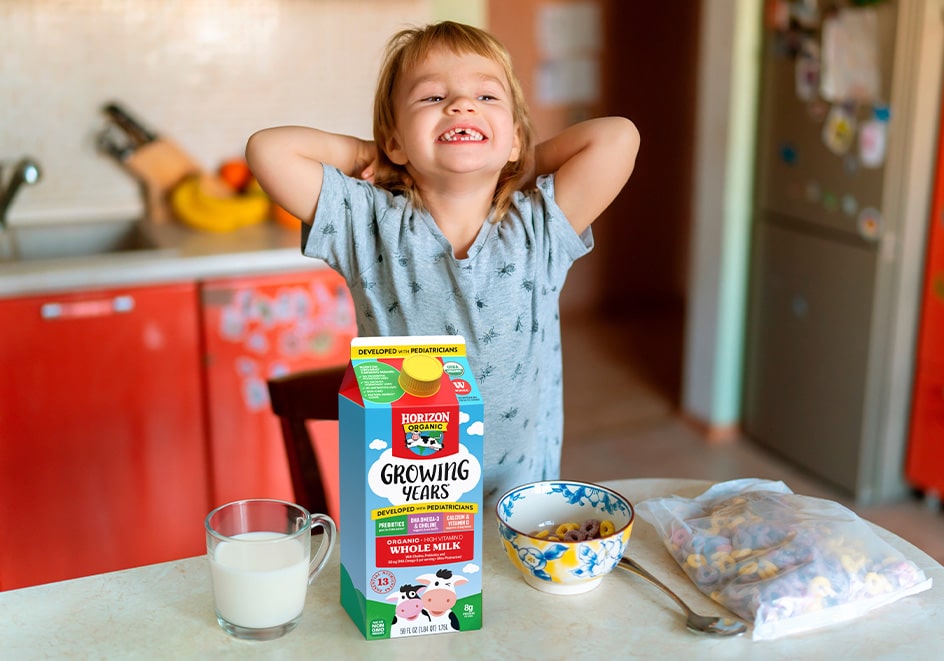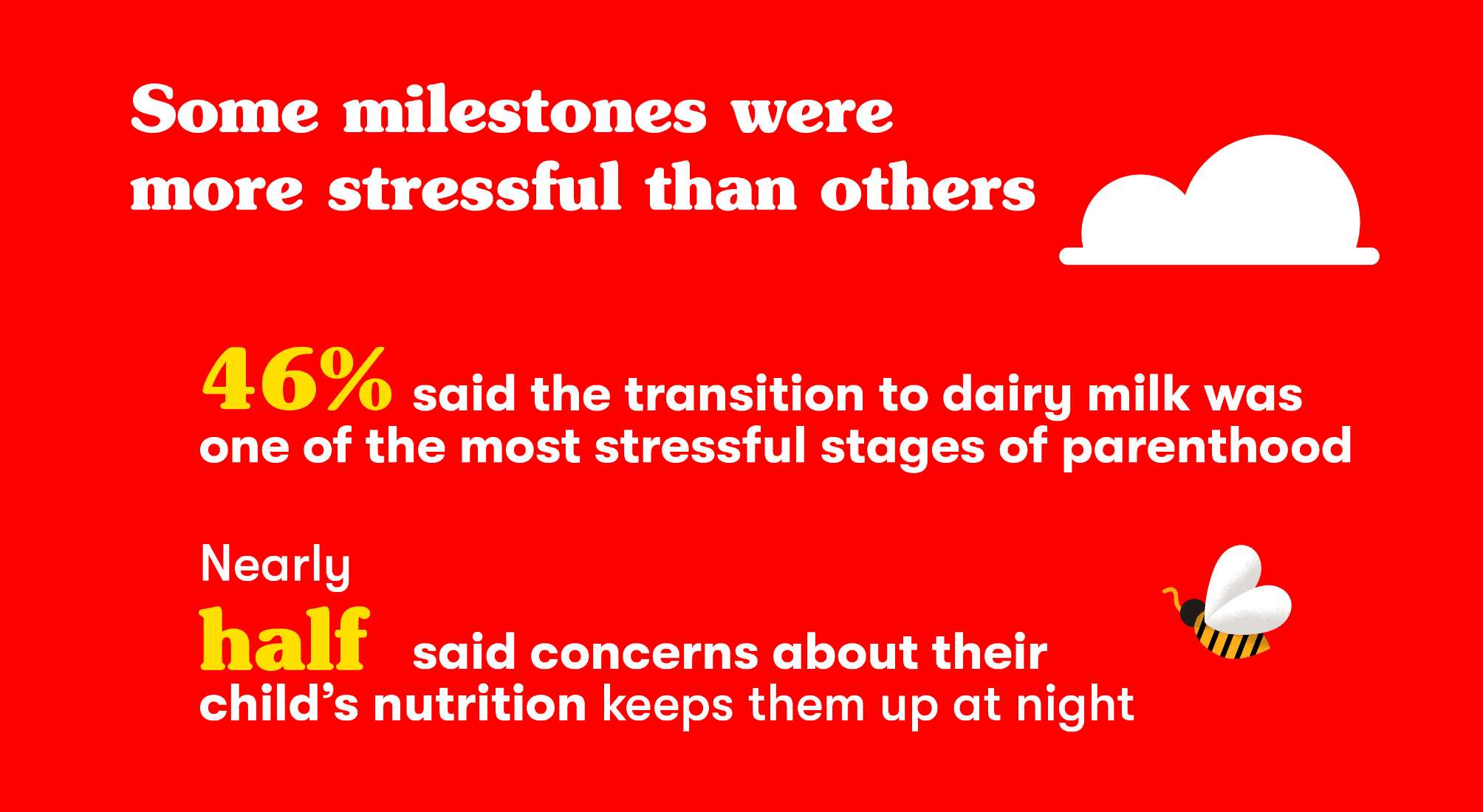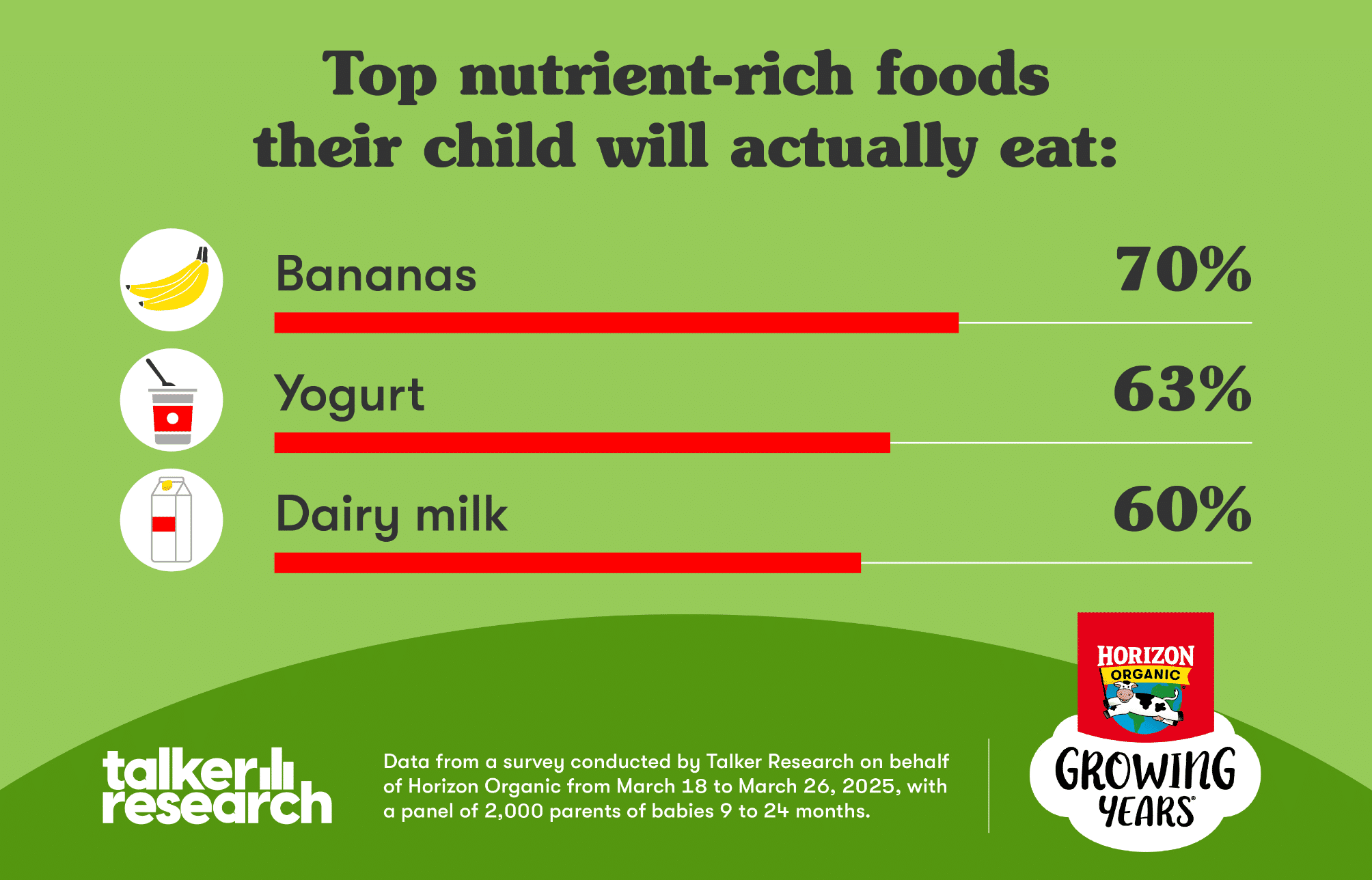

If your baby just turned one, it’s a great time to start two big transitions: from bottle to cup, and from formula or breastmilk to dairy milk. If you’re still breastfeeding, you can introduce dairy milk alongside it.
Growing Years is an ideal first milk to transition toddlers from breastmilk or formula to dairy milk because it was developed with pediatricians, uses high-quality organic dairy, and is specifically made with key nutrients for growing kids.
Horizon Organic’s Growing Years Milk provides children with protein, calcium, prebiotics, DHA Omega-3, and choline in a single cup.

Toddlers do best with routine—it gives them comfort and helps reduce tantrums (though not completely!). Transitions like moving from bottle to cup can be tough, but with a little consistency and practice, your toddler will get there. Creating a regular milk-time routine with a tasty, nutrient-filled option like Growing Years Milk can make a big difference in making the switch smoother.
Serve a small cup of Growing Years Milk alongside each of your child’s meals and snacks. Toddlers should drink about 16 oz of dairy milk per day*. This is 2-4 ounces per meal, 4-5 times per day.
Serve Horizon Organic Growing Years Whole Milk while your toddler is seated in a supportive high chair or booster seat at the table.
Giving your child a consistent location for meals will provide predictability, and the supportive chair will keep them stable and secure.
Serve Growing Years Milk in an open cup or with a straw.
Encourage your toddler to use a mature swallowing pattern and practice lip, tongue, and jaw movements important for development. Sit with your toddler and eat and drink alongside them. Remember that toddlers learn through imitation (by watching you).
Toddlerhood is a time for questioning, exercising opinions, and learning to make choices. If your little one is refusing dairy milk, here are five strategies to help.
Consistency: Keep consistently serving milk at meal and snack times. As your toddler continues to take small sips, they will grow accustomed to the taste.
Serve it warm: If your toddler is used to drinking warm formula or breastmilk, warmed dairy milk can be familiar and calming.
Blend it: Make a smoothie with Growing Years Milk, serve with yogurt or in a fruit puree. Gradually add more dairy milk and less yogurt or puree over time.
Wean over time: Start with 1 oz. Horizon Growing Years Whole Milk to 4 oz. formula or breastmilk, then gradually increase Growing Years and decrease formula or breastmilk over time.
Create a special milk-time routine: Routine helps toddlers, and special time with you can be very motivating. Use this comforting routine to help them learn. Once they are drinking dairy milk consistently, gradually move back to serving dairy milk with meals.
*Having milk served consistently with meals will develop familiarity with the taste and will give your toddler comfort knowing what to expect.

We know the first year of a baby’s life can be equally awe-inspiring and overwhelming for you as a parent. Even if it’s not your first baby, each child is unique and comes with fun surprises and new challenges.
Before a child’s first birthday, the average parent experiences nearly 50 milestones, both emotional and developmental, according to a survey of 2,000 parents conducted by Talker Research on behalf of Horizon Organic. In fact, nearly 80% of parents agreed that these milestones can seemingly come out of the blue. Way to keep us on our toes, kiddos!

For those parents surveyed, a majority were excited and prepared to experience their baby’s first steps (66%), words (62%), and to celebrate their first birthday (53%). Far fewer were ready to wean their child off breastmilk and/or formula (just 11%) as they approached their first year.

The first birthday is a wonderful milestone for a parent, but it can also be an emotional one. When weaning at around 12 months, there can be feelings of relief – so long, late-night bottle washing! – but also concerns about meeting a child’s nutritional needs.
Nearly half of parents with children aged 9-months to 24-months said the transition from formula or breastmilk to dairy milk was one of the most stressful stages of parenthood thus far, and that their concerns of whether or not their child is getting the right nutrition keep them up at night.

Dairy milk can be a go-to option you know your child will consume and enjoy, with 60% of parents saying their picky eaters will still regularly drink dairy milk along with eating bananas (70%) and yogurt (63%).
In the same survey by Talker Research, 62% of parents said it’s important for their child to consume organic foods and 85% said it’s important their child consumes foods with added nutrients like DHA Omega-3s and prebiotics. Multitasking food and drinks, like Horizon Organic’s Growing Years® Organic Milk can check multiple boxes in a single cup.

As you approach your baby’s first birthday and the introduction of dairy milk, Horizon Organic can help YOU feel confident with Growing Years® Organic Whole Milk. As the first dairy milk developed with pediatricians, Growing Years® Organic Milk uses high-quality organic dairy and is specifically formulated with key nutrients for growing kids like DHA Omega-3, choline, prebiotics, protein, and calcium. Growing Years® Organic Whole Milk can be the ideal first milk to transition toddlers from breastmilk or formula to dairy milk.
Here is what you’ll find in each serving of Growing Years® Organic Whole Milk:
Horizon Organic is ready to help you, from the first introduction of dairy milk at around 12 months and beyond. You can find more resources HERE as well as on social media – @horizonorganic on Instagram and @Horizon on Facebook.
To find Growing Years® Organic Milk at a retailer near you, visit our Store Locator.
All Parent Resources
Dairy is made up of water, fats, carbohydrates, proteins, and a variety of vitamins and minerals. The predominant carbohydrate, or “sugar” in dairy is called lactose. Lactose is found in varying amounts of milk, cheese, yogurt, cottage cheese, ice cream, and other dairy products.
Normally, when lactose is consumed, our bodies make an enzyme called lactase. Lactase is released in our small intestines and helps to break down lactose so it can be taken up by our bodies and used for energy.
Some people’s bodies are not able to breakdown or digest lactose as their bodies only make a small amount of lactase or may not make any lactase at all. For these individuals, when lactose is consumed but not broken down and absorbed properly, it continues through the intestines where bacteria are able to use it for a source of energy. As the bacteria digest the lactose, individuals may experience symptoms including gas, nausea, vomiting, bloating, “rumbling” belly sounds, belly pain, and diarrhea. The symptoms vary from person to person, ranging from mild to severe. Severity of symptoms may also be dependent on the amount of lactose consumed. While some people may be able to consume small amounts of lactose and may only have mild symptoms, others may not and can experience more severe symptoms. The occurrence of these symptoms and the inability to break down lactose is called lactose maldigestion or lactose intolerance.

Babies typically make high amounts of lactase, but this enzyme can decline or even become fully absent later in life. A lactase deficiency likely doesn’t develop until later in childhood, typically after the first 10 years of life. Different populations are also more affected than others, varying across racial and ethnic groups. Issues with breaking down lactose is lowest in those from European countries and higher in those of African, Asian and Native American descent.
If you suspect you or your child has an issue with digesting lactose, always consult your medical professional. Diagnosis and treatments should always be overseen by a doctor. There are certain diagnostic tests your doctor may use to help determine if you have lactose maldigestion or intolerance. They may also look at other conditions that have similar symptoms as lactose intolerance to help rule out other issues.
If your doctor determines you are lactose intolerant, they will likely recommend you avoid lactose containing foods and drinks. They may recommend that you take a lactase enzyme pill if you plan to consume products with lactose. They may also recommend you only consume lactose-free dairy products to help reduce and avoid unwanted symptoms. Many lactose-free dairy products have already had the lactase enzyme added to help break down the lactose. Because dairy is a readily available source of other very important vitamins and minerals, like vitamin D and calcium, it is important to make sure these are still being consumed in adequate amounts.
No, lactose free products are not the same as dairy free products. Lactose free products, especially lactose free milk, may still contain dairy proteins. Someone who has a dairy allergy, which is different than lactose intolerance, should not consume lactose free milks as they still contain dairy proteins that cause an immune response and can be life threatening. Dairy allergies often appear within the first year of life while lactose intolerance generally occurs later in life, causing the uncomfortable symptoms discussed above.
All Parent Resources
We know how important proper nutrition is during childhood. Offering a wide variety of nutrients, dairy products are an easy way to help young children get high-quality protein, vitamin D, calcium, and as pediatricians note, a fat that can serve as an energy source including for rapidly growing brains.
Developed with pediatricians, Growing Years® Organic Milk offer the goodness of dairy, along with a special bundle of added key nutrients: DHA Omega-3, choline, and prebiotics. Let’s take a look at why these nutrients are so important.

While our bodies can make a small amount of the fatty acid DHA, the process is not very efficient. DHA is best consumed through foods and dietary supplements. Common food sources of DHA include seafoods, such as salmon, mackerel, and tuna, as well as certain types of algae.
Currently, the FDA has not established a daily recommended amount of DHA. However, some important agencies have suggested minimum daily amounts for different ages. According to the Food and Agriculture Organization (FAO) of the United Nations, the following recommendations have been made:

According to What We Eat in America, NHANES 2015-2016 data, children aged 2 to 5 years consume an average of 20mg of DHA per day and children aged 6 to 11 years consume 30mg of DHA per day.
DHA is important to help support brain health but can be hard to get into kids’ everyday diets. A one-cup serving of Growing Years milk contains 50mg of DHA.
How does DHA get to the brain? That’s why Growing Years products also contain choline.
Sometimes categorized as one of the B-complex vitamins, choline is involved in many processes in the body. Much like a delivery truck, choline plays a role in helping to bring DHA to the brain, so this important fatty acid can then be incorporated into brain cell membranes.
Our bodies can make choline, but not in adequate amounts, which means it must be consumed in food or supplements. Both animal and plant food sources contain choline, including eggs, beef, chicken, and soybeans, among many others. According to the Institute of Medicine, the daily adequate intake for choline in young children is:
Every serving of Growing Years milk contains a good source of choline.

According to the International Scientific Association for Probiotics and Prebiotics (ISAPP), a prebiotic is defined as “a substrate that is selectively utilized by host microorganisms conferring a health benefit.”
This is a fancy way of saying certain compounds act as food to “feed” the good bacteria in the gut to promote their growth. Increasing the growth of the beneficial gut bacteria can then lead to a health benefit to us (their host). A prebiotic substrate can include certain types of dietary fibers, as well as other non-carbohydrate compounds.

A prebiotic is different than a probiotic, which is defined by ISAPP as a live and specific microorganism that leads to a benefit in the host when given in adequate amounts.
Derived from chicory root, the prebiotics used in Growing Years® products come from inulin, which is a type of dietary fiber. As dietary fiber, the inulin counts toward total fiber intake for the day. From the Institute of Medicine, the daily adequate intake for fiber in young children is:
However, according to data from What We Eat in America, NHANES 2015-2016, many young children on average consume just above half of these recommendations. The data reports that the average daily fiber consumption is 12.1g per day for boys 2-5 years and 11g per day for girls 2-5 years. For slightly older children, the average fiber intake is 14.7g per day for boys 6-11 and 14g per day for girls 6-11 years.
Growing Years whole and reduced fat milk each contain 1g of prebiotics per one-cup serving.
All Parent Resources
After 12 months, nutrition continues to play an important role in your child’s growth and development. By their first birthday, they have likely already tried many foods and according to the American Academy of Pediatrics (AAP), can now be introduced to whole cow’s milk. Whole milk, sometimes referred to as 4% fat milk, offers your little one a wide range of nutrients including high-quality protein, vitamin D, and calcium and also fat that can serve as an energy source important for rapidly growing brains. Developed with pediatricians, Growing Years® Organic Whole Milk contains all the nutrients of whole milk plus it is fortified with choline, DHA Omega-3, prebiotics, and is high in vitamin D.

Sometimes, the first introduction to whole cow’s milk may not go as planned and your child may not like its taste initially. Here are some tips and tricks to ease the transition to your child drinking whole milk:
Children younger than 24 months should not consume any other dairy milk other than whole milk because whole milk has a higher fat content, which is important for young children.
The AAP recommends 16 ounces of whole milk per day, and no more than 24 ounces per day, so milk is not displacing iron-rich food.

Around the time your child is transitioning to cow’s milk, their dexterity skills are advancing. They are now able to grab, hold, and release objects, such as cups and toys, making this a great time to introduce a cup. Here are some tips to help ease the transition:
You may need to try multiple cups while your child is weaning off the bottle to an open cup or straw cup.
Continued and prolonged use of a bottle or sippy cup have been associated with a higher risk of excessive weight gain, tooth decay, and the potential to displace iron-rich foods in the diet which could lead to deficiency.
Regardless of how you serve milk, consuming it when laying down to sleep can increase the risk of choking, tooth decay, and ear infection.

After the second year of life, your child has likely mastered steadily holding and drinking from an open cup. At this point, some children might be ready to start drinking a dairy milk containing a lower fat content like Growing Years Reduced Fat Milk. Please consult your child’s health care provider for specific recommendations.
Here are some facts to know as you transition:
*It is important to note that if using in combination with infant formula, the infant formula must be prepared correctly with water according to package instructions prior to mixing with whole milk.